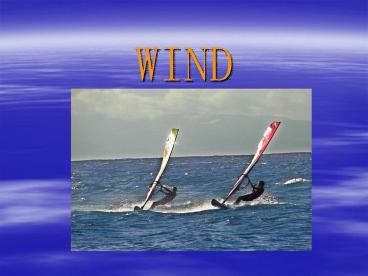WIND - PowerPoint PPT Presentation
1 / 21
Title:
WIND
Description:
Title: Worldwide Wind Current Author: Johanna Last modified by: Halifax West Created Date: 1/10/2005 12:47:44 AM Document presentation format: On-screen Show (4:3) – PowerPoint PPT presentation
Number of Views:74
Avg rating:3.0/5.0
Title: WIND
1
WIND
2
What do wind patterns have to do with oceans?
- They impact currents, waves, and weather
3
Review
- Warm air is less dense than cold air, because the
heating makes the molecules move faster and
farther apart, and this causes warm air to rise. - Cool air will flow towards and under warm air,
pushing it up and away.
4
At the equator, the surface and the air is warmer
than at any other latitude At the poles the
coldest densest air exists. The cold air from the
poles moves along the earths surface toward the
warmer regions. The air that is heated and rises
at the equator heads northward or southward, but
cools before it can reach the poles.
5
By the time warm air from the equator reaches
north or south latitudes of about 30 degrees, it
has cooled so much and become so dense that it
begins to drop back to Earths surface. For the
cold air leaving the poles, once it has reached a
latitude of 60 degrees it has warmed enough to
start to rise The result is 3 closed patterns of
air movement in each Hemisphere.
6
- Hadley cell - Low latitude air movement toward
the equator rises vertically. - Ferrel cell - A mid-latitude atmospheric
circulation cell air flows poleward and eastward
near the surface and equatorward and westward at
higher levels. - Polar cell - Air rises and travels toward the
poles where it sinks, forming the polar highs. At
the surface air diverges outward and these
surface winds create polar easterlies.
7
(No Transcript)
8
Jet Streams
Jet streams are ribbons of extremely fast moving
air near the troposphere. The Troposphere is the
lowermost portion of Earth's atmosphere. Caused
by the contact between warm and cold air Found at
boundaries between the polar and temperate zones
and between temperate zones and tropical
zones Wind speeds in a jet stream can vary from
100 km/h to 300 km/h They are thousands of
kilometers long, a few hundred kilometers wide
and two or three kilometers thick In general, the
weather north of a jet stream is cold, while the
weather south of a jet stream is warmer
9
(No Transcript)
10
Location of the Jet Location of the JetStream
in the Summer Stream in the Winter
11
Based on the previous two diagrams that showed
the general location of the jet stream in winter
and summer how can these be used to explain our
seasonal temperature changes here in Nova Scotia?
12
AIR MASSES
Although air is usually in motion, due to
convection and the Coriolis effect, large
portions of air often remain in nearly the same
place long enough to take on the temperature and
moisture characteristics of the land or ocean
below. When this occurs, a large portion of the
air is nearly uniform in temperature and humidity
and we have an AIR MASS.
Air Masses are classified as CONTINENTAL or
MARITIME, depending on whether they form over
land or ocean.
Air masses are also classified as POLAR or
TROPICAL depending on their temperature.
13
maritime polar mP
maritime polar mP
continental polar cP
maritime tropical mT
continental tropical cT
maritime tropical mT
14
Characteristics of Air Masses
Continental Polar - Cool and Dry
Maritime Polar - Cool and
Moist
Continental Tropical - Warm and Dry
Maritime Tropical - Warm and Moist
15
Pressure Systems
- A region of the earths atmosphere where air
pressure is unusually high or low.
16
High Pressure Systems
Any region where air is descending (and therefore
exerting more pressure on the area below) High
pressure systems occur when an air mass forms
over cold ground, so that the air cools by
conduction and convection. These systems are
associated with clear, cool weather. Think COLD
SNAPS! They flow clockwise in the N. hemisphere
and counterclockwise in the S. hemisphere.
17
Low Pressure System
Any region where rising air is leaving dense air
below. Intense heating of the ground can create a
low pressure system Low pressure systems are
generally very warm and they can lead to storms
and tropical cyclones. They flow counter
clockwise in the N. hemisphere and clockwise in
the S. hemisphere.
18
Hurricanes
- A hurricane is a severe tropical storm, that
forms in the southern Atlantic Ocean, Caribbean
Sea, Gulf of Mexico or in the eastern Pacific
Ocean. - Hurricanes need warm tropical oceans, moisture
and light winds above them. - If the right conditions last long enough, a
hurricane can produce violent winds, incredible
waves, torrential rains and floods. - Hurricanes rotate in a counterclockwise direction
around an "eye." - Hurricanes have winds at least 100km per hour.
- There are on average six Atlantic hurricanes each
year. - June 1 to November 30 is called hurricane season.
19
Hurricanes
- At 1210 a.m. ADT, Monday September 29, 2003,
Hurricane Juan made landfall in Nova Scotia as
one of most powerful and damaging hurricanes to
ever affect Canada.
20
- http//www.youtube.com/watch?vH9VpwmtnOZc
(hurricane destruction) - http//www.youtube.com/watch?v4f45jA5UxB0 (how a
hurricane is born)
21
To Study, Write Definitions for the Terms Below
- Cells Hadley, Ferrel, and Polar
- Jet Streams
- Air Masses Continental, Maritime, Polar,
Tropical - Pressure System High, Low
- Hurricanes































